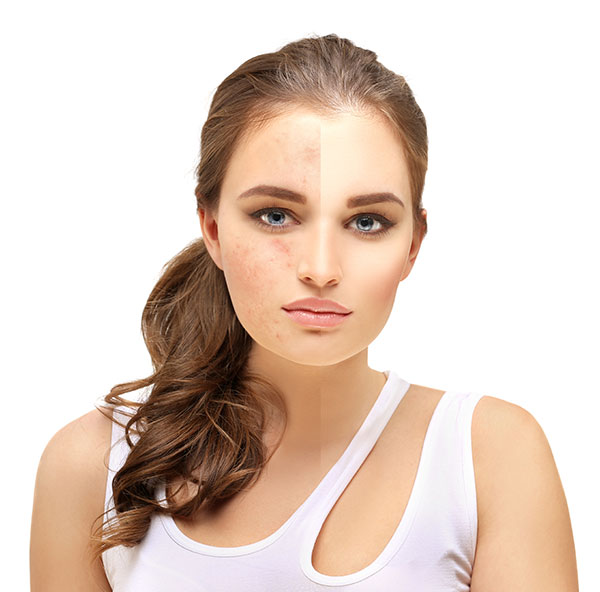As time goes by, skin changes are to be expected. Young skin is blessed with collagen[1], elastin, and tons of hydration, but too many outside factors can lead to the loss of these important elements.
When this happens, sandpapery skin is often experienced.
What Is Sandpaper Skin?
Skin can be described as sandpaper if it appears dull and muddy. Skin dullness is often caused by a build-up of dead skin cells that are not properly removed.
The skin naturally sheds off dead skin to make way for a fresh one.
What Causes Sandpaper Skin?
If after constant exfoliation, your skin still feels scaly. Best consult a physician. However, sometimes over-exfoliation can also cause the skin to overdrive and result in a few bumps on your skin.
Here are other possible causes of what makes skin feel like sandpaper.
1. Acne

Acne Causes Sandpaper Skin – Image/Shutterstock
Probably the most common reason and something most people can identify with is acne.
Excess oil and blocked glands can result in this. The bumps are often red in color, but can also have some white areas due to pus.
When some people feel like their forehead, chin or cheeks feel like sandpaper; the tiny bumps may progress into acne if not addressed right away.
2. Skin Allergy

Skin Allergy Causes Sandpapery Skin – Image/Shutterstock
A lot of skin allergies can cause illicit skin bumps, such as contact dermatitis, eczema, and hives.
These bumps are red and itchy in nature and can either be patchy, swollen, scaly, or with blisters.
A feeling of dry sandpaper skin on the face or just about anywhere on the body can also develop.
3. Keratosis Pilaris

Keratosis Pilaris Causes Sandpaper Skin – Image/Shutterstock
You might be wondering, “Why does my skin feel like goosebumps?” If your face feels like sandpaper and itches, you may be suffering from this condition.
The bumps may appear red or skin tone with a sandpaper-like texture. When dead skin does not properly fall off, some follicles may get clogged.
The appearance can be further described as having goosebumps skin all the time.
The condition is quite common in the arm area, but it can also cause the skin on the neck to feel like sandpaper, as well as on the upper thighs, buttocks, and face.
This is predominant in young people with most people experiencing it in their teenagers. It decreases or disappears by age 30.
Worsening can be observed during the dry season like the winter. For women, they might develop arm bumps during the course of pregnancy and after giving birth.
Mind you; this skin condition is not at all rare. Approximately, 4 in 10 people have it with genetics playing a strong role as a possible culprit.
4. Other Skin Conditions Such As Eczema, Rosacea, and Psoriasis

Skin Disorders – Image/Shutterstock
Redness and rough skin go hand in hand with these skin disorders.
How To Treat Sandpaper Skin?
Exfoliation is the key to having nourished, fresh, and beautiful skin. Apart from that, it is the best way on how To Treat Dull Complexion.
This should be done regularly without fail. But, what are the best exfoliators available out there? Here is a list:
- Buy a natural bristled brush. If you need a quick exfoliation without hitting the shower, you can use a natural bristled brush.
- For body exfoliation, an exfoliating glove or a loofah is a great option to use when showering.
- For your face or body, skin-friendly exfoliating scrubs are worth the investment. A scrub should contain pits, sugar, salt, or any exfoliating substance so long as it is natural.
These are actually available in just about any drugstore or natural food store. Start by brushing in a small area before moving on to the next. Begin in the lower legs and proceed to work your way up to the chest, back, and arms.
How To Get Rid Red Dots On Skin?
For people who are experiencing acne and skin allergies, consulting a dermatologist may be a better fit for you. Generally, here are some tips on getting rid of the red spots caused by marks from acne or skin allergy:
- Any ingredient with skin lightening properties, such as lemon, aloe, or honey can do the trick.
- Using baking soda as a thin mask on your face can reduce redness and lighten the skin in the long run.
- Egg whites contain amino acids and proteins that can lighten the skin and tighten the pores.
- Coconut oil is not only one of the best skin moisturizers of natural source, but it can also lessen inflammation and speed up the healing of marks and scars.
- Apart from lightening the scars, cucumber can help combat irritation and itching because of its cooling effect.
Other Tips For People Who Have Keratosis Pilaris
- Always, always moisturize your skin. This is definitely one of the seasonal skincare tips because this should be done day in, day out, no questions asked. If you have the condition, all the more reason for you to moisturize your skin several times a day. Creams and petroleum jelly work well. If not, consult a physician and request OTC medicated creams that contain glycolic acid or lactic acid.
- A chemical peel can remove the excessive dead skin cells, or at the very least, your dermatologist might suggest the use of Tretinoin.
- Deep yourself into a hot bath and wash with a brush, loofah, or a washcloth. Take your time doing this.
- A humidifier kept on low humidity is a total God-send during winter months.
How to Prevent Sandpaper Skin?
The same way you treat the condition is almost the same way to prevent it, such as:
- Regular exfoliation at least three times a week on body and face.
- Avoiding over exfoliation and harsh scrubbing of the skin.
- Using a heavy-duty moisturizer, one that contains urea as an ingredient.
- Applying a sunblock every day before leaving your home.
FAQ’s:
Que: How do I get rid of keratosis pilaris?
Ans:
- Reducing the size of the bumps. Lotion and cream with medicines such as salicylic acid, lactic acid, urea, or tretinoin can help reduce the bumps.
- Keep your skin moisturized. Put lotion or cream regularly on the areas with bumps.
Que: Can keratosis pilaris go away?
Ans: It usually goes away on its own over time – often fading by age 30.
Que: Does exfoliating help keratosis pilaris?
Ans: Yes, it helps to keratosis pilaris.
Conclusion
Sandpaper skin can be a sign of an underlying condition.
If you have checked with your physician and no diagnosis was made, this article is actually beneficial for you, and you can learn a lot from it.
Otherwise, stick to your provided medications and always care for your physician’s advice.

 By Wendy Gould
By Wendy Gould






